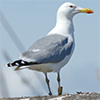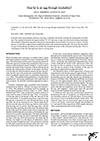 Larus cachinnans in the Netherlands
Larus cachinnans in the Netherlands
(last update: December 24, 2021)
Albert de Jong
Leon Kelder
Roland-Jan Buijs
Thijs Horst
Merijn Loeve
Mars Muusse
Cachinnans breeding in the Netherlands - breeding ecology
| you can participate in this project too! please send in your observations of colour ringed birds to: ring@buijsecoconsult.nl |
PROSPECTING & AGE AT FIRST SETTLEMENT
At this moment (2021), only few birds had been ringed before settling in this colony, therefore it is not possible to draw any conclusion yet. We did observe several breeding birds with obvious sub-adult features in wing and/or tail, either 4CY or 5CY birds.
We started the ringing program in 2020, we hope to see those ringed birds returning and settling at De Kreupel and Lelystad in the near future.
| nest code | bird | year | age | comments |
| r-02P4 | K.G was 02P4 | 2020 | 7CY | From Poland. Maybe present in 2019? In 2017 (4CY) breeding bird at Amerongen, the Netherlands. |
| y-PNED | PNED | 2019 | 7CY | From Poland. Maybe present in 2018? |
| y-PLDP | PLDP | 2019 | 8CY | From Poland. Maybe present in 2018? |
| y-PHSV | PHSV | 2020 | 10CY | From Poland. Late-May 2016 prospecting (?) at Posthof - Frankfurt, Germany. |
| y-P:A02 | P:A02 | 2021 | 5CY | From Poland. |
| y-P:U60 | P:U60 | 2021 | 4CY | From Poland. |
| g-XLHD | XLHD | 2020 | 5CY | From e Germany. |
| g-XLDT | XLDT | 2017 | 5CY | From e Germany. In 2017, previous to Lelystad, breeding attempt at Amerongen, the Netherlands (with r-02P4). |
| y-X804 | X804 | 2020 | - | From e Germany. |
| w-201:U | 201:U | 2021 | 6CY | From Czech Republic. |
| -- | 327:U | 2021 | 4CY | Never at nest, just prospecting at Lelystad? |
| zy-MT | M.T | 2021 | 9CY | Hybrid Yellow-legged Gull from the Netherlands. |
BREEDING DENSITY IN THE COLONIES
Population density in some sections of the colony may have repercussions and impact on chick survival rate. We have multiple observations and documentation of egg loss and chick mortality (cannibalism) in the densely populated colonies along the coast (colony Maasvlakte and colony Texel). Thus far, distances between nests don’t give rise to expect this happening much at Lelystad or De Kreupel. However, we have one sections with nests closely grouped together: nest 60-62-63 at dam – south section at Lelystad, and we may have to follow this cluster in more detail to see if this is relevant here. Maybe coincidentally, or not, we found a predated Caspian Gull egg at nest 62.
EGG LAYING DATE & HATCHING DATE
We assume the female lay three eggs within a 3 or 4 days period. (Check 1: % of birds in known studies like Camphuysen that do not get a 3-eggs clutch. Check 2: have deviations been described for the assumption that on three consecutive days there is a new egg?)
We use an average incubation period of 28 days, as described for Herring Gull in: The breeding biology of Herring and Lesser Black-backed Gulls on Texel, 2006-2010.
We used four methods to estimate laying date of eggs.
- The ‘water test”. Eggs were placed in a small transparent plastic container, filled with water. The angle (from lying flat 0° to straight up 90°) and position (touching bottom container to floating) is an indication for development and age of the embryo inside the egg.
- We coded several nests containing only one or two eggs (A-egg, B-egg). We used a permanent marker to write the ‘A’ and ‘B’ on the shell. If, in a next visit, the same nest contained a ‘full clutch’ of three eggs, we assume the new egg to be C-egg, and in retrospect, our last visit indicate the laying date. (pitfalls: see check 1 and check 2)
- We witnessed small cracks in egg shells, indicating hatching date for a pullus. When using an assumed breeding period of 30 days, we are able to extrapolate the egg laying date. (Check 3: how many hours is a chick busy freeing itself from the shell? Do other, comparable studies have details on this? Check 4: what parameters may influence the total breeding time of 28 days and may this vary substantially from year to year? Check 5: what is the SD for the mean breeding period?)
- In the first week after hatching, when chicks are still really small, you can estimate with relative good accuracy the hatching date for a chick, and, again, using the 28-days breeding period, you can estimate laying date (check 6: weakness of faults in twofold-assumption construction)
Water test for eggs - the scheme is developed by dr Jacek Betleja for Polish Caspian Gulls (25 days incubation period) The sequence of laying (A-egg, B-egg and C-egg) can be read from the position an egg has in a container filled with water. The ‘slope’ or angle predicts the sequence. Stage I is a fresh egg, laid this day or 1 day ago; II-VI are the positions for eggs laid 2-22 days ago; VII is a hatching egg). The A-egg, laid first, should be more advanced in embryo development than the B-egg, and the B-egg should more advanced than the C-egg. Estimating the angle is easier when you draw a scale on ther container.
|
Hans Schekkerman kindly calculated egg laying date for the selceted nests in 2020 at Lelystad. The full excel is availble HERE. Conclusions are:
| Nest Code | Hatch Date | Lay Date |
| Nest01 | 09-05-2020 | 07-04-2020 |
| Nest02 | 05-05-2020 | 03-04-2020 |
| Nest03 | 05-05-2020 | 03-04-2020 |
| Nest06 | 29-05-2020 | 27-04-2020 |
| Nest08 | 07-05-2020 | 05-04-2020 |
| Nest09 | 06-05-2020 | 04-04-2020 |
| Nest11 | 29-04-2020 | 28-03-2020 |
| Nest12 | 11-05-2020 | 09-04-2020 |
| Nest13 | 11-05-2020 | 09-04-2020 |
| Nest14 | 05-05-2020 | 03-04-2020 |
| Nest15 | 06-05-2020 | 04-04-2020 |
| Nest17 | 04-05-2020 | 02-04-2020 |
| Nest18 | 07-05-2020 | 05-04-2020 |
| Nest21 | 14-05-2020 | 12-04-2020 |
| Nest27 | 11-05-2020 | 09-04-2020 |
| Nest29 | 10-05-2020 | 08-04-2020 |
| Nest31 | 21-05-2020 | 19-04-2020 |
| Nest32 | 13-05-2020 | 11-04-2020 |
| Nest33 | 04-05-2020 | 02-04-2020 |
| Nest35 | 10-05-2020 | 08-04-2020 |
| Nest36 | 05-05-2020 | 03-04-2020 |
| average | 09-05-2020 | 07-04-2020 |
| SD | 6,5 | 6,5 |
| min | 29-04-2020 | 28-03-2020 |
| max | 29-05-2020 | 27-04-2020 |
| N nests | 21 | 21 |
DEPARTING THE COLONY AFTER BREEDING
What date do parents leave the colony?
What date do juveniles leave the colony?
FLOATERS - DECISION NOT TO BREED
Observations of well prepared nests, but despite the energy put into this, the adults did not start breeding this season.
SITE FIDELITY - TIME SERIES
From pictures.
PARTNER FIDELITY - TIME SERIES
From pictures.
SYMPATRIC BREEDING - BETWEEN-SPECIES DYNAMICS
Territorial disputes and hierarchy.
Parent of "nest r02P4 21" in season 2021.
Parent of "nest 006" in season 2019-2021. Originally, ringed as pullus in Poland.
 Caspian Gull cachinnans PHSV 11CY, 2021, Lelystad, the Netherlands.
Caspian Gull cachinnans PHSV 11CY, 2021, Lelystad, the Netherlands.Parent of "nest 064" in season 2021. Originally, ringed as pullus in Poland.
Parent of "nest 005" in season 2019 and 2020. Originally, ringed as pullus in Poland.
 Caspian Gull cachinnans PNED 8CY-9CY, 2020-2021, Lelystad, the Netherlands. Picture: Mars Muusse.
Caspian Gull cachinnans PNED 8CY-9CY, 2020-2021, Lelystad, the Netherlands. Picture: Mars Muusse.Parent of "nest 002" in season 2019-2021. Originally, ringed as pullus in Poland.
 Caspian Gull cachinnans P:A02 5CY, March - June 2021, Lelystad, the Netherlands. Picture: Mars Muusse & Albert de Jong.
Caspian Gull cachinnans P:A02 5CY, March - June 2021, Lelystad, the Netherlands. Picture: Mars Muusse & Albert de Jong.Parent of "nest 057" in season 2021. Originally, ringed as pullus in Poland.
 Caspian Gull cachinnans P:U60 4CY, March - June 2021, Lelystad, the Netherlands. Picture: Mars Muusse & Albert de Jong.
Caspian Gull cachinnans P:U60 4CY, March - June 2021, Lelystad, the Netherlands. Picture: Mars Muusse & Albert de Jong.Parent of "nest 068" in season 2021. Originally, ringed as pullus in Poland.
Parent of "nest 008" in season 2019 and 2020. Originally, ringed as pullus in Germany.
 Caspian Gull cachinnans XLHD 5CY-6CY, April-June 2020 & 2021, De Kreupel - B,
the Netherlands. Picture: Leon Kelder.
Caspian Gull cachinnans XLHD 5CY-6CY, April-June 2020 & 2021, De Kreupel - B,
the Netherlands. Picture: Leon Kelder.As 4CY, it visited the native colony in Germany in the breeding season, however, as 5CY it started breeding in Holland. Parent of "nest XLHD 21".
 Caspian Gull cachinnans X804 adult, immigrant from east Germany, breeding in 2020 at De Kreupel colony, labelled "nest K06". Originally, ringed as pullus in Germany.
Caspian Gull cachinnans X804 adult, immigrant from east Germany, breeding in 2020 at De Kreupel colony, labelled "nest K06". Originally, ringed as pullus in Germany. Caspian Gull cachinnans 201:U 6CY, May 20 2021, De Kreupel - D,
the Netherlands. Picture: camera trap.
Caspian Gull cachinnans 201:U 6CY, May 20 2021, De Kreupel - D,
the Netherlands. Picture: camera trap. Parent of "nest 201U 21" in season 2021. Originally, ringed as pullus in Czechia.
 Caspian Gull cachinnans 327:U 4CY, May 28 2021, Lelystad, the Netherlands. Picture: Albert de Jong.
Caspian Gull cachinnans 327:U 4CY, May 28 2021, Lelystad, the Netherlands. Picture: Albert de Jong.Inspecting the colony, or a breeder that has settled unnoticed? Originally, ringed as pullus in Czechia.
 How far is an egg through incubation?
How far is an egg through incubation? LES G. UNDERHILL & KATHY M. CALF
Wader Study Group Bulletin 106 April 2005
 How to measure eggs in gulls?
How to measure eggs in gulls? Measuring angle of egg to determine laying date.
Measuring angle of egg to determine laying date. Nest 35, April 16 2021 at Lelystad colony, the Netherlands.
